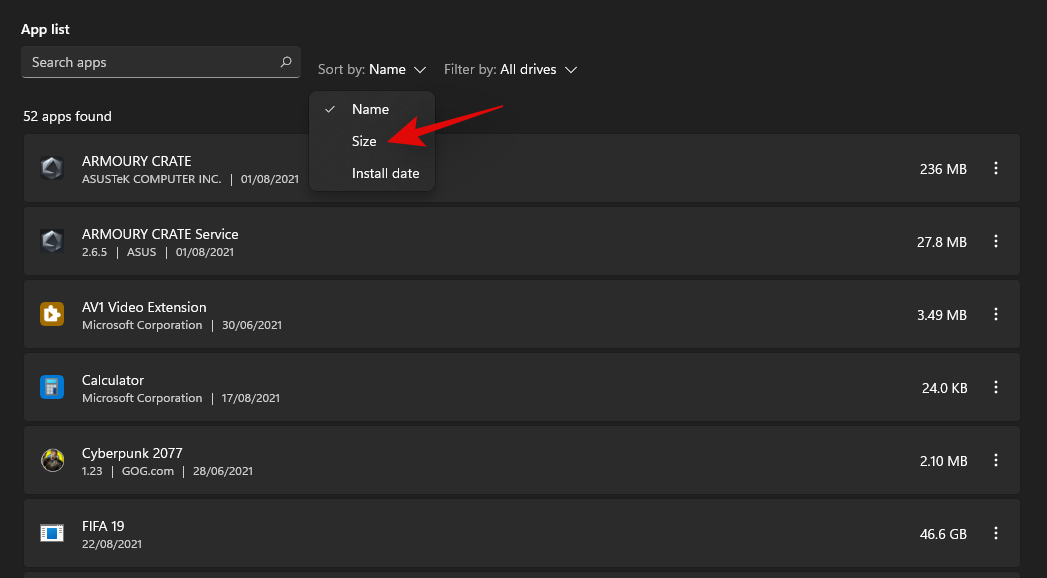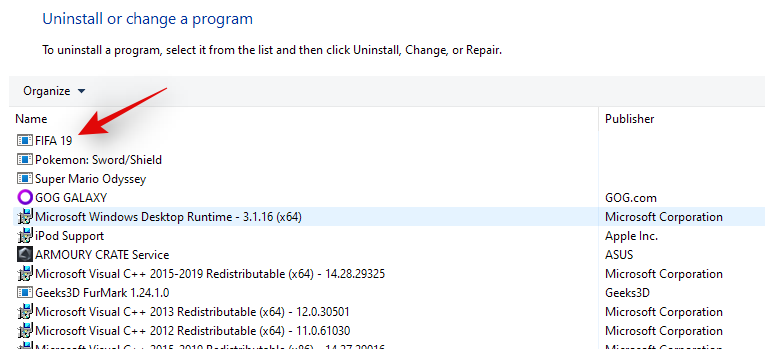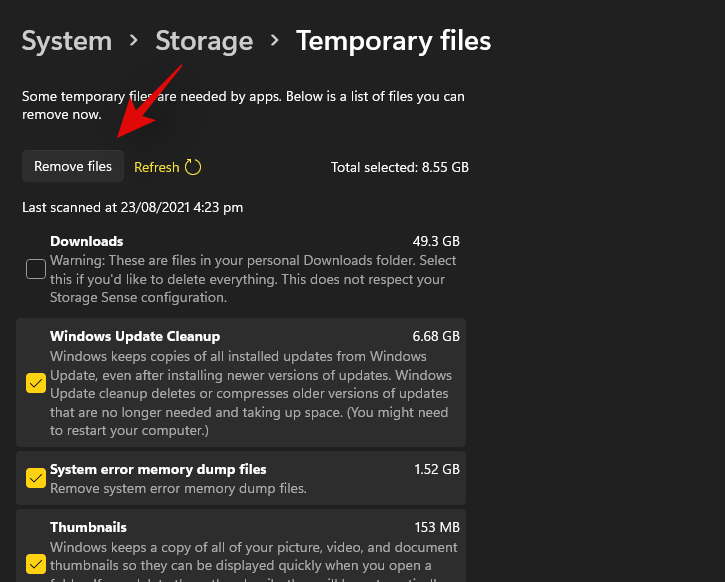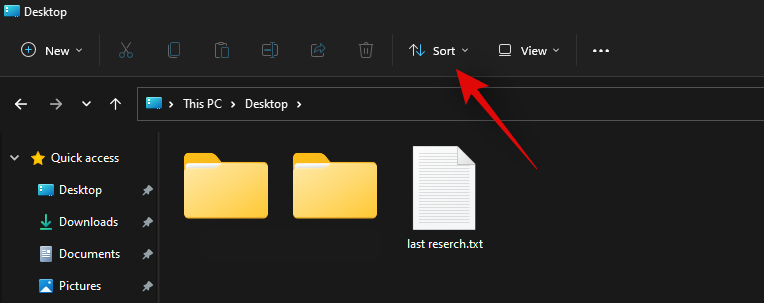What to know
- You can clear storage space in several different ways, from uninstalling apps to hunting down large files and folders, as well as removing temporary Windows files.
- Uninstall apps from the Settings app > Apps > Installed apps.
- Free up temporary files from the Settings app > System > Storage > Temporary files.
- You can also search for large files in File Explorer's search by using 'size', followed by ':gigantic', ':huge', ':large', and ':medium'. Alternatively, Sort the files by Size.
- You can also rely on several third-party apps such as WinDirStat abd SpaceSniffer to hunt down and remove files and folders taking up unnecessary space.
Disk Space has always been a luxury, be it the old days of DOS where everything was stored on a floppy disk or our modern times where we find it difficult to store our music libraries on a single drive. Depending on your current system configuration you could easily run out of space as you keep using your system.
This space could be used for temporary files, paging files, old Windows, large archives, download files, and more. The best way to free up some space tends to be to delete the largest files on your system, but finding these files can prove to be a challenge. In such cases, you can use our guide below to identify and delete the largest files on your system. Let’s get started.
Related: How to Fix Windows Search High CPU or Disk Usage on Windows 11
Free up space on Windows 11
You can easily check for huge files on your system in Windows 11 (or 10) using various methods. Windows 11 comes with an in-built utility as well that helps you identify files taking large amounts of storage space on your PC. Follow one of the methods below that best suits your current needs and requirements.
Method 1: Uninstalling Apps that are taking large space
Video Guide
Step-by-step guide with screenshots
Step 1: Press Windows + I on your keyboard to launch the Settings app and click on ‘Storage’ on your right.

You will now get a list of all the categories taking up large chunks of disk space on your PC. Click on the category of your choice to get started. Follow the steps below depending on your choice.
Step 2: Click on ‘Sort by’ at the top.

Step 3: Select ‘Size’.

Step 4: The largest apps and programs on your system will now be listed in descending order. Click on the ‘3-dot’ menu icon beside the app you wish to remove from your PC.

Step 5: Select ‘Uninstall’.

Step 6: Click on ‘Uninstall’ again to confirm your choice.

The app should now be uninstalled from your system.
If you were redirected to the Control Panel
Step 1: Click and select the app you wish to delete/uninstall.

Step 2: Click on ‘Uninstall’ at the top.

Step 3: The uninstallation program should now launch on your PC. Follow the on-screen instructions to remove the selected program from your system.

The selected program should now be removed from your system.
Related: How to Repair Windows 11 [15 Ways]
Method 2: Free up space using ‘temporary files’ option under Storage settings
Video Guide
Step-by-step guide with screenshots
Step 1: Your temporary files will already be listed in descending order by their size. Check the boxes for all the temporary files you wish to remove from your PC.

Note: Selecting ‘Downloads’ will delete your personal files stored in the ‘Downloads’ folder.
Step 2: Click on ‘Remove files’ at the top to remove the selected temporary files from your PC.

Temporary files should now be cleared from your system.
Related: How to delete temporary files in Windows 11
Method 3: Free up space by sorting files and folders by size
You can quickly identify the files and folders that are taking up a large chunk of space on your PC by sorting them by size. You can then check if there are any that you don't need and can delete them altogether.
Video Guide
Step-by-step guide
Step 1: Press Win+E to open the File Explorer. Then navigate to a location to check the storage.
Step 2: Click on ‘Sort’ at the top.

Step 3: Click on ‘More’.

Step 4: Now select ‘Size’.

Step 5: Your files will now be listed in descending order by their size. Select the files you wish to delete and hit Del on your keyboard.

Step 6: Now click on ‘Yes’ to confirm your choice.

Selected files should now be deleted from your selected folder.
Method 4: Using WinDirStat
WinDirStat is a popular open-source utility often used to generate a graphical representation of your local storage space in a user-friendly manner. This makes it easier to identify large chunks of your disk space occupied by a single file, folder, or archive, which in turn will make it easier for you to free up some space on your PC. Use the guide below to identify what is taking up space on your Windows 11 PC.
Video Guide
Step-by-step guide with screenshots
- WinDirStat | Download Link
Step 1: Download and install WinDirStat on your PC using the link above. Once installed, launch the app.

Step 2: Now select one of the options that best suits your needs. If you only have a single drive installed on your system with a single partition, then you can skip this step. Click on ‘Ok’ once you are done.

- All Local Drives: This will make WinDirStat analyze all your disks and display their data graphically.
- Individual Drives: Select one of your installed drives to be analyzed for disk space usage. You can select this option and then select the drive you wish to use.
Step 3: Your drives will now be analyzed and you can track the progress for the same at the bottom of the window.

Step 4: Once analyzed, a color-coded graphical representation of the disk space usage on the selected drive(s) will be shown on your screen. Simply click on the largest chunks to identify the largest files.

Step 5: Press Del on your keyboard to delete the file. This will send it to your recycle bin and you can decide its fate when reviewing your recycle bin items. Alternatively, you can use Shift + Del to permanently delete the item from your system.

And that’s it! You can repeat the last steps to delete more of the largest files from your system.
Method 5: Using Windows Search to delete large files
Windows Search can also help you identify the larges files on your system in Windows 11. Use the guides below to get started.
Video Guide
Step-by-step guide
Step 1: Press Windows + E on your keyboard to open the file explorer and click on the search box in the top right corner. Search for the following term.
size:gigantic

Step 2: The results will now be filtered and files larger than 4GB will now be displayed on your screen. Select the unnecessary files that you do not need on your PC and simply delete them to free up some space. If you wish to use a smaller minimum file size, then replace ‘gigantic’ with one of the terms below depending on the size you prefer.

- Large: Files between 128MB and 1GB
- Huge: Files between 1GB to 4GB
- Medium: Files between 1MB to 128MB
And that’s it! You can use Windows Search this way to filter files by their size and find the largest ones currently on your PC.
Note: In case your PC indexes and shows system files as well then we recommend you double check files before deleting them to avoid deleting any vital system files from your system.
You will now have found large files on your PC using Windows Search.
Method 6: Using CMD (command prompt)
CMD can also help you find large files on your system. Use the guide below to get you started.
Step 1: Press Windows + E on your keyboard and navigate to a location where you wish to search for large files and click on the address bar at the top.

Step 2: Type in CMD and press Enter on your keyboard.

Step 3: CMD will now be launched in the particular folder. Type in the following command and replace ‘PATH’ with the path we copied to your clipboard.
forfiles /S /M * /C “cmd /c if @fsize GEQ 1073741824 echo @path > largefiles.txt

Step 4: The above command will look for files larger than 1GB on your PC. If you wish to define a larger minimum size, then replace ‘1073741824’ with one of the following options below.
- 2GB: 2147483648
- 5GB: 5368709120
- 10GB: 10737418240
Step 5: Execute the command with your desired variables and a text file will be created in the same location with a list of all the large files found on your system based on your criteria. You will also find the path for each file on your local storage in the text file.

Step 6: You can use this list to identify the largest files in the current location and then delete them at your discretion to free up some disk space on your system.
Method 7: Using PowerShell
You can also find large files on your system using PowerShell. Just like the command for CMD, PowerShell will scour your local files based on a minimum size and display all the files larger than it. Use the guide below to get you started.
Step 1: Press Windows + E on your keyboard and navigate to the location where you wish to look for large files. Click on the address bar at the top and type in ‘PowerShell’. Press Enter on your keyboard once you are done.

Step 2: Copy-paste the command below in the PowerShell window and press Enter on your keyboard.
gci -r| sort -descending -property length | select -first 10 name, length

You will now get a list of the top 10 largest files currently taking the most disk space on your system. If you wish to view the top 20 files, then replace ‘select-first 10’ with ‘select-first 20’.
PowerShell will now find and display the 20 largest files on your system along with their size. The file size will be in bytes which can make it a bit difficult to judge the size of files in terms of gigabytes.

And that’s it! You will now have found the largest files on your PC using PowerShell in Windows 11.
Method 8: Using SpaceSniffer
Space Sniffer is another popular third-party utility used to analyze disk space usage on Windows 11. Space sniffer can help you identify large files using huge amounts of space on your system. You can also find hidden files taking huge disk space on your PC using the SpaceSniffer. Use the guide below to get you started.
Video Guide
Step-by-step guide with screenshots
- SpaceSniffer | Download Link
Step 1: Download SpaceSniffer to your PC using the link above. A portable .exe will be downloaded to your system. Extract the archive and right-click on the .exe file.

Step 2: Select ‘Run as administrator’.

Step 2: Now select the drive you wish to scan. If you wish to analyze and find large files in a particular directory, then you can enter its path in the text box below.

Step 3: You will now be shown a graphical representation of your disk space usage on your screen. Simply hover over the largest chunk and you will be shown the name of the folder or file occupying that space.

And that’s it! You can use SpaceSniffer this way to identify the largest files on your system by simply looking at the largest chunks on your screen.
Method 9: Other third-party tools you can use to analyze disk usage on Windows 11
The world of third-party tools is a rabbit hole. The more you look, the more programs you will find that claim to help you find and reclaim your disk space on Windows 11. This huge selection of programs can be quite daunting and challenging at first, making it difficult for you to find the perfect tools that fit your current needs and requirements. If you are not a fan of one of the programs used above, then you can opt for one of the alternatives listed below. You can find a few details about each program below their listing.
- TreeSize Free | Download Link | Freemium model
- JDiskReport | Download Link | Freeware model
- SpaceMonger | Download Link | Freemium model
- RidNacs | Download Link | Freeware model
- FolderSize | Download Link | Open-Source model
Tips to free storage space on Windows 11
If you are running low on disk space or have a smaller-sized drive that you are unable to currently upgrade, then you can use the following tips to save as much disk space on your PC as currently possible. Let’s get started.
- Use Disk Cleanup
- Run SFC & DISM commands to fix errors with your drives
- Uninstall unnecessary apps
- Delete or Archive unnecessary or currently unused files
- Use OneDrive or other cloud storage services to save space
- Use an external storage device to store your libraries
- Regularly free up your recycle bin
- Use Storage Sense on Windows 11
- Disable Hibernation to delete the hibernation file
- Rebuild your search index
- Delete additional users created on your system
And more. You can free up space on your PC using tons of ways but each usually comes with a compromise. If you are looking to avoid compromises, then upgrading your storage is the best option. SSDs are cheaper than ever and if you are looking to upgrade your storage, then an SSD could go a long way for your system.
Free up disk space on Windows 11!
Using the numerous methods above, you can easily find what’s taking up space on your PC and fix it pretty easily. If the Windows-based solutions do not work for you, try using a free-ish software like TreeSize (or others mentioned above).
If you still need help with clearing up space on your Windows 11, then let us know in the comments box below. Do explain your issue properly.
RELATED












Discussion